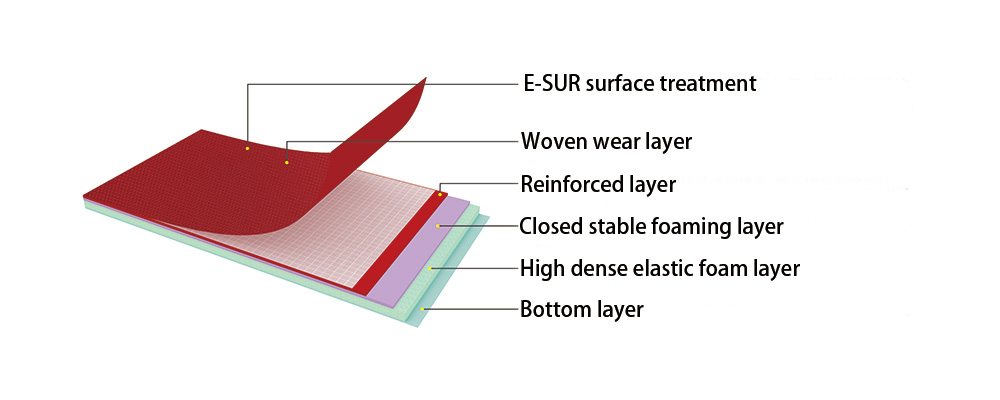Aug . 07, 2024 13:35 Back to list
Choosing the Best Rubber Flooring Materials for Playground Safety and Durability
The Benefits of Rubber Flooring in Playgrounds
Rubber flooring has gained immense popularity as a primary choice for playground surfaces due to its numerous advantages, making it a safe and appealing option for children’s play areas. When considering playground surfaces, safety, durability, and environmental impact are paramount. Rubber flooring offers all these benefits and more, ensuring that children can play freely while minimizing the risks of injuries.
Safety First
One of the most significant advantages of rubber flooring is its ability to cushion falls, reducing the risk of injury. Children are naturally active, and falls are an inherent part of play. Unlike traditional surfaces like concrete or grass, rubber flooring absorbs impact, making it ideal for playgrounds where safety is a primary concern. The shock-absorbing qualities of rubber can significantly lower the chances of serious injuries from falls, providing parents and guardians with peace of mind.
Durability and Maintenance
Rubber playground flooring is known for its durability and longevity. It can withstand heavy foot traffic, extreme weather conditions, and wear and tear from play activities without losing its integrity. Unlike traditional materials that may crack, fade, or degrade over time, rubber surfaces maintain their appearance and functionality for years with minimal maintenance. Regular cleaning and occasional inspections are usually sufficient to keep rubber floors in optimal condition, making them a cost-effective long-term solution for playgrounds.
Environmentally Friendly
playground floor material rubber

In recent years, there has been a growing emphasis on sustainability, and rubber playground flooring aligns well with this trend. Many rubber surfaces are made from recycled materials, such as old tires, reducing waste and promoting environmental responsibility. By choosing rubber flooring, communities can contribute to recycling efforts while providing safe play environments for children. Furthermore, rubber is often free from harmful chemicals, ensuring that the surfaces children play on are safe and non-toxic.
Aesthetically Pleasing and Versatile
Rubber flooring is not only functional but also aesthetically pleasing. It comes in a variety of colors, shapes, and textures, allowing playground designers to create visually appealing spaces that engage children’s imaginations. Brightly colored rubber tiles or seamless poured rubber surfaces can be used to design unique play areas that attract children and encourage them to engage in physical activity. The versatility in design allows playgrounds to cater to different age groups and types of play, from climbing and running to jumping and rolling.
Accessibility
Another critical aspect of rubber flooring is its inherent accessibility. It provides a smooth surface that is wheelchair-friendly and suitable for children with mobility challenges. This inclusivity ensures that all children, regardless of their physical abilities, have the opportunity to engage in play. By creating accessible playgrounds, communities can foster a culture of inclusivity and support children in developing social skills and physical fitness.
Conclusion
Rubber flooring is an excellent choice for playground surfaces, offering a unique blend of safety, durability, environmental friendliness, and aesthetic appeal. As communities continue to invest in outdoor play areas, the benefits of rubber surfaces make them a leading contender for creating safe, engaging, and inclusive environments for children. By prioritizing the safety and enjoyment of play, rubber flooring not only enhances the playground experience but also contributes positively to the overall well-being of children. Therefore, when planning or renovating playgrounds, rubber flooring should be at the forefront of considerations for creating the perfect play space.
-
Professional Tennis Court Lining Services Pickleball Court Marking Experts
NewsJun.24,2025
-
Pickleball Court for Sale - Premium Flooring Solutions for Sports Venues
NewsJun.10,2025
-
Maple Grove Outdoor Pickleball Courts - Premium Conversion & Durable Materials
NewsJun.10,2025
-
Best Pickleball Outdoor Courts Solutions Convert Tennis Courts, Outdoor Covered Courts, Maple Grove Options
NewsJun.10,2025
-
Convert Tennis Court to Pickleball Fast & Affordable
NewsJun.09,2025
-
Indoor Outdoor Pickleballs Durable & All-Weather for Any Court Play
NewsJun.09,2025

